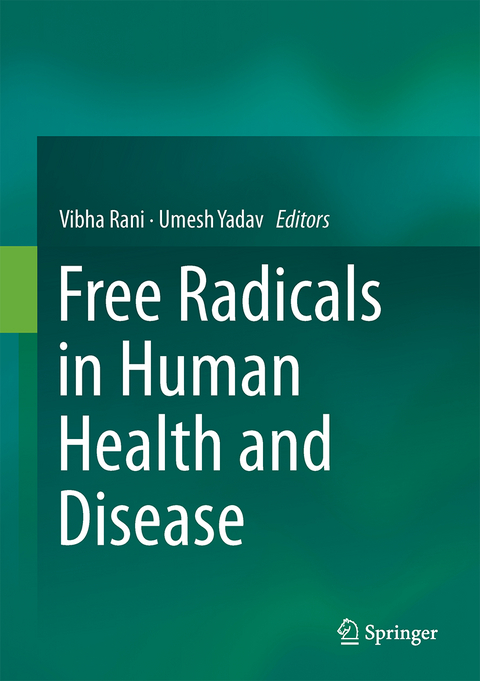
Free Radicals in Human Health and Disease
Springer, India, Private Ltd (Verlag)
978-81-322-2034-3 (ISBN)
The role of oxidative stress in human disease has become an area of intense interest. Free radicals, a normal product of metabolism, exist in all aerobic cells in balance with biochemical antioxidants. Environmental stress increases the levels of free radicals drastically, thereby disturbing the equilibrium between free radical production and the antioxidant capability causing oxidative stress. Over the years, ROS has been implicated in the pathologies of various diseases like cancer, neurological disorder, cardiovascular diseases rheumatoid arthritis, diabetes etc. This book provides an in depth critical state-of-art reviews from established investigators on free radicals, ROS associated pathogenesis of human diseases, biomarkers of oxidative damage, antioxidants, phytonutrients and other related health concerns of modern society.
The present book is aimed at graduate students, researchers in academia, industry and clinicians with the interest in redox biology. Special attention has been devoted to the topic of ROS signalling, oxidative stress induced human pathologies & antioxidative therapies. The book consists of four parts in specified topics based on the current literatures for the better understanding of the readers with respect to their subject-wise interests. The first section of the book provides an overview about the ROS production and their measuring tools and techniques followed by the mechanisms involved in the oxidative stress in the second section. The third section describes the involvement of oxidative stress in different human diseases and the last section focuses on the different strategies to ameliorate oxidative stress induced stress.
Dr Vibha Rani is working as an Assistant Professor in the Department of Biotechnology, Jaypee Institute of Information Technology, Noida, India. After completing her Doctoral Studies from School of Life Sciences, Jawaharlal Nehru University, New Delhi, she has continued her academic career where she teaches as well as guides doctorate students in the area of oxidative stress-induced cardiomyopathy and other development-related heart Diseases. She is an academician as well as an accomplished young scientist and has been in research for fourteen years. She has received extra-mural funding for her research work from the Department of Science and Technology (DST) and Department of Biotechnology (DBT), Govt. of India. Her research focus is to understand the mechanism of action of phytomolecules and also to develop ideal drug molecule for prevention of cardiac diseases. She has been successfully able to communicate her research findings to various International Journals. Dr. Umesh C S Yadav is currently working as an Assistant Professor at the School of Life Sciences, Central University of Gujarat, Gandhinagar. Dr Yadav has Ph.D. degree from School of Life Sciences, Jawaharlal Nehru University, New Delhi. He has over nice years of research experience, six years as postdoctoral fellow and more than three years as faculty, from the University of Texas Medical Branch (UTMB) Galveston, Texas, USA where he performed excellent research in oxidative stress-induced inflammatory pathologies such as diabetic and cardiovascular complications, lung inflammatory diseases including asthma and chronic obstructive pulmonary disease (COPD) and ocular inflammatory diseases. He has published more than 30 research articles in high impact journals including reviews and book chapters which indicate his expertise in the area of oxidative stress and inflammatory diseases and associated signalling pathways. Dr Yadav has been awarded a prestigious Ramanujan Fellowship from Department of Science and Technology (DST), New Delhi and has recently returned to his native country, India, where he has established his laboratory.
Part I – Free Radical Generation.- 1. Production of Reactive Oxygen Species and its Implication in Human Diseases.- 2. Reactive Oxygen Species and Cellular Defense System.- 3. The Noxious Nanoparticles.- 4. Tools and Techniques to measure Oxidative Stress.- Part II – Mechanism of Oxidative Stress.- 5. Impact of Oxidative Stress on Human Health.- 6. Gene-environment interaction in Oxidative Stress-induced Pathologies.- 7. Oxidative Stress Induced Molecular and Genetic Mechanisms in Human Health and Diseases.- 8. Hydrogen Peroxide Sensing and Signalling.- Part III – Oxidative Stress and Diseases.- 9. Oxidative Stress-Induced lipid Peroxidation: Role in Inflammation.- 10. Oxidative Stress and its Biomarkers in Cardiovascular Diseases: An overview.- 11. Free Radicals and Oxidative Stress in Neurodegenerative Disorders.- 12. Thyroid Gland in Free Radical Induced Oxidative Stress.- 13. Oxidative Stress Events and Neuronal Dysfunction in Alzheimer’s Disease: Focus on APE1/Ref-1 Mediated Survival Strategies.- 14. ROS in Carcinogenesis and Anticancerous Drug Induced Toxicity.- 15. Oxidative Stress in Low Birth Weight Newborns.- 16. Oxidative Stress and Diabetes.- 17. Oxidative Stress and Inflammation in Cardiovascular Diseases: Two Sides of the Same Coin.-18. Redox Biology of Aging: Focus on Novel Biomarkers.- Part IV – Strategies to Ameliorate Oxidative Stress Induced Diseases.- 19. Antioxidant Supplements: Friends or Foe?.- 20. Linking Toll-like Receptors Signalling to Oxidative Damage: Potential Role in Cancer Therapy.- 21. Management of Inflammation using Cellular Redox Modifiers.- 22. Oxidative Stress, Antioxidant Status and Redox Signalling in Carcinogenesis.- 23. Role of ROS in Bacterial Resistance and Biofilm Formation and possible Therapeutics.- 24. Antioxidants and other Potent Strategies to Reduce Oxidative stress in semen.- 25. Nano-encapsulation of a Natural Polyphenol, Green Tea Catechins: way to Preserve its Anti-oxidative Potential.- 26. Food Protein-Derived Antioxidative Peptides.
| Zusatzinfo | 60 Illustrations, color; 24 Illustrations, black and white; XVI, 430 p. 84 illus., 60 illus. in color. |
|---|---|
| Verlagsort | New Delhi |
| Sprache | englisch |
| Maße | 178 x 254 mm |
| Themenwelt | Medizin / Pharmazie ► Medizinische Fachgebiete |
| Studium ► 1. Studienabschnitt (Vorklinik) ► Biochemie / Molekularbiologie | |
| Naturwissenschaften ► Biologie ► Biochemie | |
| Naturwissenschaften ► Biologie ► Mikrobiologie / Immunologie | |
| Naturwissenschaften ► Biologie ► Zellbiologie | |
| ISBN-10 | 81-322-2034-X / 813222034X |
| ISBN-13 | 978-81-322-2034-3 / 9788132220343 |
| Zustand | Neuware |
| Haben Sie eine Frage zum Produkt? |
aus dem Bereich


